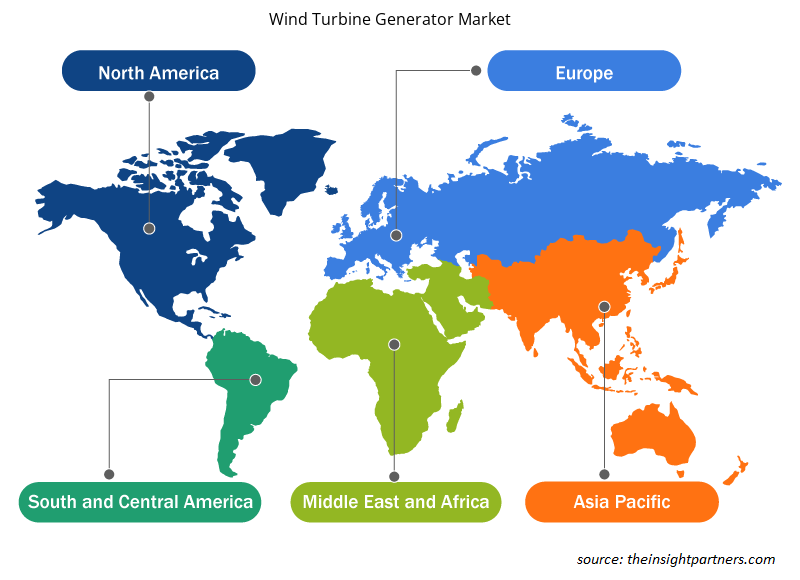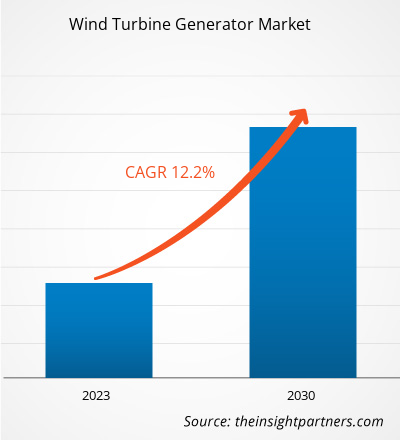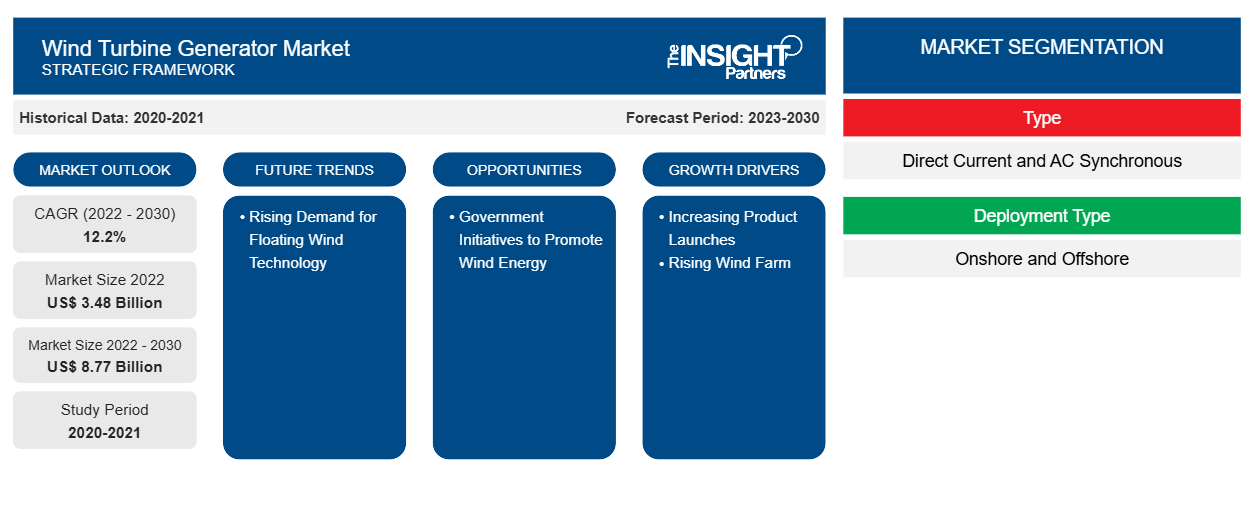[Forschungsbericht] Der Markt für Windturbinengeneratoren wurde im Jahr 2022 auf 3.483,84 Millionen US-Dollar geschätzt und soll bis 2030 8.772,57 Millionen US-Dollar erreichen; für den Zeitraum 2022–2030 wird ein durchschnittliches jährliches Wachstum von 12,2 % erwartet.CAGR of 12.2% during 2022–2030.
Analystenperspektive:
Der nordamerikanische Markt für Windturbinengeneratoren ist in die USA, Kanada und Mexiko unterteilt. Aufgrund strenger staatlicher Vorschriften, erhöhter Investitionen in Windkraftprojekte, günstiger politischer Maßnahmen und sinkender Kosten für Windenergie wird erwartet, dass die Windindustrie in der gesamten Region ein bemerkenswertes Wachstum verzeichnet. Mit dem wachsenden Bewusstsein der Verbraucher für den Klimawandel und die Rolle erneuerbarer Energien wird erwartet, dass die Nachfrage nach Windturbinen in Nordamerika steigen wird. Im Jahr 2022 installierten allein die USA (Texas) landgestützte Windturbinen mit einer Leistung von 4.028 MW. Auch die anderen US-Bundesstaaten wie Nebraska und Oklahoma fügten im Jahr 2022 jeweils eine Windkraftkapazität von 600 MW hinzu. All diese Regierungsinitiativen treiben das Wachstum des Marktanteils von Windturbinengeneratoren in den USA voran.
Die kanadische Regierung investiert in erneuerbare Energien und arbeitet mit einheimischen Partnern zusammen, um große Projekte zu realisieren. So kündigte der Minister für natürliche Ressourcen im Mai 2022 eine Investition von ca. 50 Millionen US-Dollar für die Burchill Wind Limited-Partnerschaft zwischen Wolumseket und Natural Forces Development an, um erneuerbare Energien und Technologien zur Netzmodernisierung einzusetzen. Im März 2022 kündigte Kanada seine Pläne an, 7,2 Milliarden US-Dollar in Wind- und Solarprojekte zu investieren, um die Ziele zur Reduzierung der CO2-Emissionen bis 2030 zu erreichen. Im November 2021 gab Siemens Gamesa Renewable Energy bekannt, dass sie eine Vereinbarung mit Renewable Energy Systems (RES) in Kanada zur Lieferung von Windturbinen für das 100-MW-Windprojekt Hilda in Alberta unterzeichnet haben. Dieser Deal wird dem Land helfen, sein Ziel zu erreichen, bis 2030 30 % erneuerbare Energie zu erzeugen. Im Rahmen dieser Vereinbarung wird Siemens Gamesa 20 SG 5.0-145-Turbinen liefern und damit sauberen und erschwinglichen Strom für ca. 50.000 Haushalte liefern. Laut der Canadian Renewable Energy Association (CanREA) hat Kanada im Jahr 2022 insgesamt 1,8 GW Wind- und Solarstromkapazität installiert. Solche Investitionsaussichten für den Bau von Windenergieprojekten und die zunehmende Nutzung sauberer Energie beflügeln den Marktanteil nordamerikanischer Windturbinengeneratoren. Verschiedene Akteure auf dem Markt für Windturbinengeneratoren wie TPI Composites Inc., Marmen Inc., Valmont Industries Inc. und The Timken Co. entwickeln innovative und effizientere Komponenten, um dieser steigenden Nachfrage gerecht zu werden.
Die mexikanische Regierung hat erhebliche Summen in den Bau von Windkraftanlagen im Land investiert. Laut der Asociación Mexicana de Energía Eólica (AMDEE) sind im Jahr 2020 Investitionen in Höhe von ca. 1,3 Milliarden US-Dollar für die Entwicklung des mexikanischen Windenergiesektors geplant. Damit hat das Land mit dieser Investition einen Platz unter den drei attraktivsten Windenergieproduzenten Lateinamerikas erreicht. Die zugewiesenen Mittel werden in 11 Windenergieprojekte in Coahuila, Yucatan und Tamaulipas investiert.
Somit treiben alle oben genannten Faktoren das Wachstum des nordamerikanischen Marktes für Windturbinengeneratoren voran.
Passen Sie diesen Bericht Ihren Anforderungen an
Sie erhalten kostenlose Anpassungen an jedem Bericht, einschließlich Teilen dieses Berichts oder einer Analyse auf Länderebene, eines Excel-Datenpakets sowie tolle Angebote und Rabatte für Start-ups und Universitäten.
-
Holen Sie sich die wichtigsten Markttrends aus diesem Bericht.Dieses KOSTENLOSE Beispiel umfasst eine Datenanalyse von Markttrends bis hin zu Schätzungen und Prognosen.
Marktübersicht:
Generatoren wandeln die von den Rotorblättern erzeugte mechanische Energie durch Magnetfelder in elektrische Energie um. In den meisten Fällen verwenden Generatoren Wechselstrom, um mit einer konstanten Drehzahl zu arbeiten, die es ihnen ermöglicht, 60-Hz-Wechselstrom in Versorgungsqualität zu erzeugen. In Windkraftanlagen werden verschiedene Generatortypen verwendet, darunter Induktionsgeneratoren (mit fester und variabler Drehzahl), doppelt gespeiste Induktionsgeneratoren (variable Drehzahl) und Generatoren mit Permanentmagnet-Direktantrieb. Sie verfügen über unterschiedliche Merkmale und Betriebsfähigkeiten, die je nach den Anforderungen der Windkraftanlageninstallation und Stromerzeugung eingesetzt werden.
Die wachsende staatliche Initiative zur Nutzung von Windenergie zur Stromerzeugung schafft lukrative Möglichkeiten für den Markt für Windturbinengeneratoren. Die steigende Nachfrage nach schwimmender Windtechnologie für Offshore-Windturbinen wird voraussichtlich das Wachstum des Marktes für Windturbinengeneratoren im Prognosezeitraum begünstigen. Die Technologie wird bei der Entwicklung von Offshore-Windturbinen in sehr tiefen Gewässern helfen.
Markttreiber:
Zunehmende Produkteinführungen treiben das Wachstum des Marktes für Windkraftanlagengeneratoren voran
Laut dem Global Wind Energy Council (GWEC) waren bis 2022 weltweit insgesamt 906 GW Windkapazität installiert, davon 93 % an Land und 7 % auf See. Es wird erwartet, dass sich die Windenergiemärkte in den kommenden 20 Jahren vervierfachen werden, was die Nachfrage nach fortschrittlichen Windturbinenkomponenten weiter steigen lässt. Die steigende Nachfrage nach Windenergie erfordert fortschrittliche Turbinenkomponenten wie Rotorblätter, Gondeln, Getriebe, Generatoren, Türme und Pitchsysteme. Dies hat die Marktteilnehmer gezwungen, ihre Investitionen in die Entwicklung neuer und innovativer Produkte zu erhöhen. Verschiedene Hersteller von Windturbinen arbeiten daran, fortschrittliche Produkte einzusetzen, um den wachsenden Kundenanforderungen gerecht zu werden. So kündigte Adani New Industries Ltd im September 2023 an, eine 5,2-MW-Serie von Windturbinengeneratoren für den internationalen Windturbinengeneratormarkt herzustellen.
Solche Fortschritte bei Windturbinenkomponenten, unterstützt durch hohe Investitionen globaler Hersteller und staatliche Maßnahmen zur Klimakontrolle zur Erweiterung ihres Produktportfolios, treiben das Wachstum des Marktes für Windturbinengeneratoren voran. Auch die steigende Nachfrage nach recycelbaren Komponenten zum Schutz der Umwelt drängt die Hersteller dazu, mehr recycelbare Komponenten zu entwickeln. Darüber hinaus entwickeln die Hersteller effizientere Komponenten, die dazu beitragen, mehr Strom aus Windturbinen zu erzeugen , indem sie die Ausfallzeiten der Turbinen reduzieren. Somit treibt die wachsende Produktinnovation entsprechend den sich ändernden Kundenanforderungen das Wachstum des Marktes für Windturbinengeneratoren voran.
Segmentanalyse:
Basierend auf dem Generatortyp ist der Markt für Windturbinengeneratoren in Gleichstrom und Wechselstrom-Synchrongeneratoren unterteilt. Im Jahr 2022 eroberte das Segment Wechselstrom-Synchrongeneratoren aufgrund seiner Netzkompatibilität und Betriebseffizienz einen größeren Anteil am globalen Markt für Windturbinengeneratoren. Darüber hinaus sind Wechselstromgeneratoren bei Offshore-Windparks besonders vorteilhaft. Sie eignen sich gut für die Stromübertragung über große Entfernungen von Offshore-Anlagen zum Festland, da Wechselstrom effizient über ausgedehnte Unterseekabeldistanzen transportiert werden kann. Es wird erwartet, dass wachsende Offshore-Investitionen die Nachfrage nach Wechselstrom-Synchrongeneratoren auf dem Markt für Windturbinengeneratoren ankurbeln werden. So kündigte beispielsweise das britische Unternehmen Octopus im Jahr 2023 seine Pläne an, 20 Milliarden US-Dollar in Offshore-Windparks zu investieren. Solche Initiativen werden voraussichtlich die Nachfrage nach Wechselstrom-Synchrongeneratoren ankurbeln.
Regionale Analyse:
Die italienische Regierung investiert beträchtliche Summen in die Integration erneuerbarer Energien und treibt damit den Marktanteil des Landes bei Windkraftanlagen weiter voran. So gab ERG im Juni 2022 bekannt, dass sie einen Auftrag über 101 MW für den Windpark Mineo Militello Vizzini auf Sizilien erteilt haben. Dieses Projekt ergänzt die mehr als 5,4 GW starken Windkraftanlagen, die Vestas in Italien installiert hat oder im Bau hat, was einem Marktanteil von mehr als 40 % entspricht. Außerdem gab Eni im Juli 2021 bekannt, dass sie eine Vereinbarung zur Übernahme von 100 % eines Portfolios von 13 Onshore-Windparks in Italien mit einer Gesamtkapazität von 315 MW von Glennmont Partners („Glennmont“) und PGGM Infrastructure Fund („PGGM“) unterzeichnet haben. Die italienische Regierung arbeitet auch an Anreizen, um den Ausbau von Offshore-Windkraftanlagen voranzutreiben. Darüber hinaus hat sich die Regierung zum Ziel gesetzt, 65 % des Strombedarfs des Landes durch erneuerbare Energieträger zu decken. Dies ist ein weiterer wichtiger Faktor, der im Prognosezeitraum voraussichtlich neue Möglichkeiten für Anbieter auf dem Markt für Windkraftanlagen schaffen wird.
Regionale Einblicke in den Markt für Windkraftanlagengeneratoren
Die regionalen Trends und Faktoren, die den Markt für Windturbinengeneratoren im Prognosezeitraum beeinflussen, wurden von den Analysten von Insight Partners ausführlich erläutert. In diesem Abschnitt werden auch die Marktsegmente und die Geografie von Windturbinengeneratoren in Nordamerika, Europa, im asiatisch-pazifischen Raum, im Nahen Osten und Afrika sowie in Süd- und Mittelamerika erörtert.

- Erhalten Sie regionale Daten zum Markt für Windturbinengeneratoren
Umfang des Marktberichts über Windkraftanlagen
| Berichtsattribut | Details |
|---|---|
| Marktgröße im Jahr 2022 | 3,48 Milliarden US-Dollar |
| Marktgröße bis 2030 | 8,77 Milliarden US-Dollar |
| Globale CAGR (2022 - 2030) | 12,2 % |
| Historische Daten | 2020-2021 |
| Prognosezeitraum | 2023–2030 |
| Abgedeckte Segmente |
Nach Typ
|
| Abgedeckte Regionen und Länder |
Nordamerika
|
| Marktführer und wichtige Unternehmensprofile |
|
Marktteilnehmerdichte für Windkraftanlagen: Auswirkungen auf die Geschäftsdynamik verstehen
Der Markt für Windturbinengeneratoren wächst rasant, angetrieben durch die steigende Nachfrage der Endnutzer aufgrund von Faktoren wie sich entwickelnden Verbraucherpräferenzen, technologischen Fortschritten und einem größeren Bewusstsein für die Vorteile des Produkts. Mit steigender Nachfrage erweitern Unternehmen ihr Angebot, entwickeln Innovationen, um die Bedürfnisse der Verbraucher zu erfüllen, und nutzen neue Trends, was das Marktwachstum weiter ankurbelt.
Die Marktteilnehmerdichte bezieht sich auf die Verteilung der Firmen oder Unternehmen, die in einem bestimmten Markt oder einer bestimmten Branche tätig sind. Sie gibt an, wie viele Wettbewerber (Marktteilnehmer) in einem bestimmten Marktraum im Verhältnis zu seiner Größe oder seinem gesamten Marktwert präsent sind.
Die wichtigsten auf dem Markt für Windturbinengeneratoren tätigen Unternehmen sind:
- XINJIANG GOLDWIND SCIENCE & TECHNOLOGY CO LTD
- Vestas Wind Systems AS
- General Electric,
- Zhejiang Windey Co., Ltd.
- Suzlon Energy Limited
Haftungsausschluss : Die oben aufgeführten Unternehmen sind nicht in einer bestimmten Reihenfolge aufgeführt.

- Überblick über die wichtigsten Akteure auf dem Markt für Windkraftanlagengeneratoren
Schlüsselspieleranalyse:
Siemens Gamesa Renewable Energy SA; ENVISION Group; Mingyang Smart Energy; Nordex SE; Xinjiang Goldwind Science & Technology Co., Ltd.; Vestas Wind Systems AS; General Electric; Zhejiang Windey Co., Ltd.; Suzlon Energy Limited; Enercon GmbH; und Nordex Group gehören zu den wichtigsten Akteuren auf dem Markt für Windturbinengeneratoren.
Aktuelle Entwicklungen:
Anorganische und organische Strategien wie Fusionen und Übernahmen werden von Unternehmen auf dem Markt für Windkraftanlagen häufig eingesetzt. Nachfolgend sind einige aktuelle Entwicklungen der wichtigsten Akteure auf dem Markt für Windkraftanlagen aufgeführt:
|
Datum
|
Nachricht
|
Region
|
|
Oktober 2023 |
Mingyang Smart Energy hat Pläne für eine neue Offshore-Windturbine angekündigt, die mit 22 MW die größte Offshore-Windturbine der Welt sein wird. Laut dem Unternehmen ist die taifunresistente MySE 22MW sowohl für den Einsatz auf festem Boden als auch auf schwimmenden Anlagen geeignet. Die Turbine soll laut dem Unternehmen zwischen 2024 und 2025 gebaut werden. |
Asien & Pazifik |
- Historische Analyse (2 Jahre), Basisjahr, Prognose (7 Jahre) mit CAGR
- PEST- und SWOT-Analyse
- Marktgröße Wert/Volumen – Global, Regional, Land
- Branchen- und Wettbewerbslandschaft
- Excel-Datensatz
Aktuelle Berichte
Verwandte Berichte
Erfahrungsberichte
Grund zum Kauf
- Fundierte Entscheidungsfindung
- Marktdynamik verstehen
- Wettbewerbsanalyse
- Kundeneinblicke
- Marktprognosen
- Risikominimierung
- Strategische Planung
- Investitionsbegründung
- Identifizierung neuer Märkte
- Verbesserung von Marketingstrategien
- Steigerung der Betriebseffizienz
- Anpassung an regulatorische Trends























 Kostenlose Probe anfordern für - Markt für Windturbinengeneratoren
Kostenlose Probe anfordern für - Markt für Windturbinengeneratoren